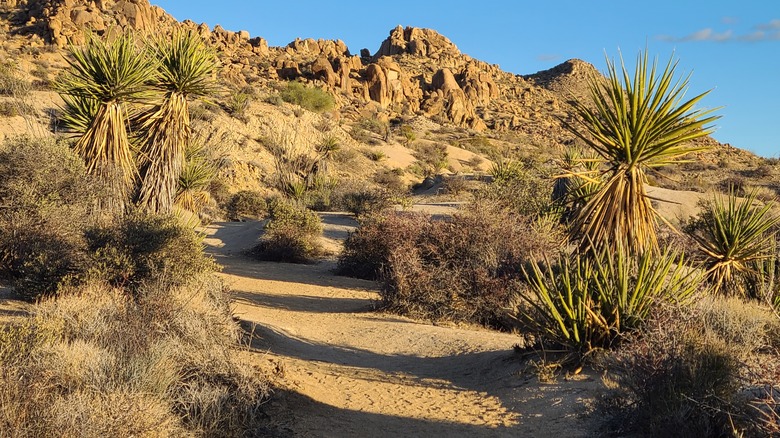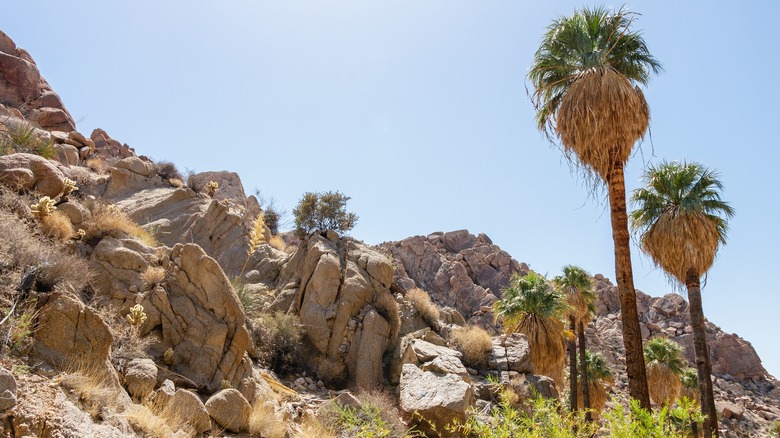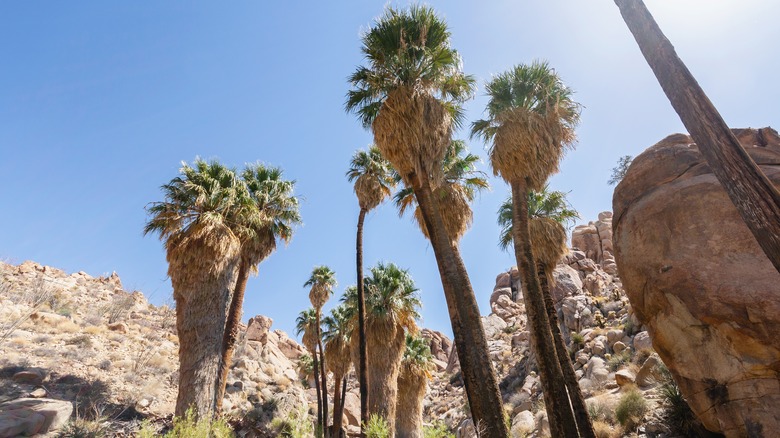Avoid The Crowds And Enjoy The Views On This Breathtaking Joshua Tree National Park Hike
What would Joshua Tree National Park look like without the record-breaking crowds and without its titular trees? That's a thought that may enter one's mind when visiting this California park during the busy season (from October to May) and reflecting back on two massive, headline-making wildfires in other parts of the Mojave Desert. In 2020 and 2023, the Dome Fire and York Fire (named for the Cima Dome woodland and New York Mountains) razed an estimated 2.5 million Joshua trees in the Mojave National Preserve.
Joshua Tree National Park, located about 70 miles away, is where the Mojave meets the Colorado Desert. Unbeknownst to some visitors, Joshua Tree does have a trail called Lost Palms Oasis that's mostly devoid of the gnarled, spiky trees that give the park its name. While not entirely devoid of people, the Lost Palms Oasis Trail is much less crowded than other hiking routes or sightseeing spots in Joshua Tree (which ranks among America's 10 most-visited national parks). That means you're less likely to see Instagrammers staging photo shoots or tourists damaging or disturbing landmarks.
In a park with an area called the Hall of Horrors, it's easy to imagine overtourism and climate change facilitating the spread of another devastating wildfire and turning Joshua Tree into California's next yucca graveyard. That's all the more reason to "preserve its natural beauty," as desert conversation activist Minerva Hoyt (namesake of a 5,405-foot mountain in the park) put it. One way to do that is by taking the trail less traveled — in this case, Lost Palms Oasis — and keeping it free of litter.
Hike the Lost Palms Oasis Trail
As its name suggests, the Lost Palms Oasis Trail still rewards hikers with the sight of trees, but they're fan palms and chollas instead of Joshua trees. The 7.5-mile, out-and-back hike begins in one literal desert oasis, Cottonwood Spring, and ends in another. If you're on a day trip from Los Angeles or Palm Springs, you can take I-10 to exit 168 and be on the trail shortly. Park at the Cottonwood Visitor Center, near the South Entrance to Joshua Tree National Park, and follow the trail sign down the dirt path to the first oasis of palm trees and cottonwoods.
Cottonwood Spring is where the trailhead for both Mastodon Peak and Lost Palms Oasis is. It's less than a mile before the former splits off from the latter, taking most other hikers off on a separate loop trail. On Tripadvisor, as of this writing, the Lost Palms Oasis Trail actually ranks as the 20th most popular thing to do in Joshua Tree. That may be because it's a moderate to difficult hike that requires a serious time commitment.
In contrast to the Hidden Valley Trail — an easy, 25-minute, 1-mile loop, which remains well-trodden, despite its name — the Lost Palms Oasis Trail will occupy you for four hours or more. If you're making a return visit to Joshua Tree, you may already be accustomed to arriving in the morning to avoid the midday crowds. It helps to do that still on the Lost Palms Oasis Trail, since you'll be baking in the sun for hours while you hike. Needless to say, bring a good supply of water and sunscreen.
See the promised land of over 100 palms
The Lost Palms Oasis Trail makes a 500-foot elevation gain through the rolling desert hills in Joshua Tree National Park. Along the way, you'll twist through narrow canyons and have plenty of cacti to keep you company. The scenery gets more interesting as you go along, with sandy washes (dry areas where water previously ran) giving way to striking rock formations and a final, picture-perfect canyon view.
Like the similarly named Fortynine Palms Oasis Trail, the hike to Lost Palms Oasis ends in the sight of looming treetops in the desert. Here, you'll be looking down on over a hundred of them from above — unless you descend further into the canyon. Either way, the view is breathtaking enough to make the long hike worth it. This is one of those middle-of-nowhere, center-of-everywhere places, where you might feel far from civilization but deeply connected to the heart of nature. Keep in mind, you'll spend the last couple of hours hiking back the way you came, with the rocky climb back out of the canyon being particularly challenging.
As the story goes, the Joshua tree got its name from Mormon pioneers, who saw in its limbs the biblical Joshua, raising his arms to the heavens on a journey into the promised land. In its own way, the remote Lost Palms Oasis does arrive like a promised land of sorts for dedicated hikers. Should you leave feeling cheated of Joshua trees, however, you can get your fill of those on the equally time-consuming Panorama Loop Trail. You'll also take in stunning mountain views on this trail.


